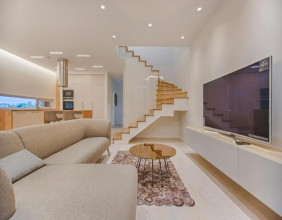1930s semis have real character; bay windows, wide hallways, and solid builds. But beneath the surface, they can hide age-related issues.
Before you commit to buying, it’s smart to have the place looked over properly. Keep reading to find out what kind of survey gives you the answers you need.
Why Your Home’s Age Matters
A home built in the 1930s is unlikely to follow modern standards. You’ll often find timber floors, original brickwork, and roofing that has been patched over the years. Some of these houses have been extended or had walls knocked through - changes that might affect how sound the structure is.
Surveys can help spot issues in older or altered homes, but not every report offers the same depth. That’s why it’s important to choose a survey that suits the property's age and condition.
What Is a HomeBuyer Report?
“A Level 2 HomeBuyer Report is designed for homes that are in decent condition and built with standard materials”, confirms Liverpool home buyers survey experts, SAM Conveyancing. It offers a general overview of what’s visible and accessible. That includes things like:
- Damp patches in the walls or ceilings
- Cracked tiles or missing sections on the roof
- Doors and windows that don’t close properly
- Early signs of structural movement
It’ll also point out anything that might need urgent repairs. What it won’t do is dig behind walls or lift floorboards. If you're not planning major work, it could be a practical and affordable choice.
When to Choose a Building Survey
If the home’s been heavily altered, extended, or just hasn’t been looked after well, a Level 3 Building Survey might be the better option. It gives you a deeper look at the property’s structure and highlights potential problems that aren’t always obvious.
This type of survey is thorough. It can tell you what materials were used, whether parts of the house are wearing out, and where hidden damage could be waiting. You’ll also get recommendations if anything needs further investigation.
Common Problems in 1930s Homes
These homes weren’t built with today’s materials, and that means a few things are worth checking:
- Old electrics and plumbing, which might need upgrading for safety
- Rot or insect damage in wooden beams and floorboards
- Subsidence, often caused by nearby trees or clay-heavy soil
- Single glazing, which can affect warmth and noise levels
Catching these early helps you plan repairs or renegotiate the price.
How to Decide What’s Right for You
Think about the condition of the home. If it’s been looked after and hasn’t had much done to it, a Level 2 survey might cover what you need. But if it's larger, things feel outdated or you’re unsure about previous work, it’s better to go with a full Building Survey.
You can always speak to a qualified surveyor for guidance. They’ll consider the age, layout, and visible issues before recommending the right option for you.
Don’t Skip This Step
Surveys aren’t just another bit of paperwork. For a 1930s semi-detached home, they can uncover problems that might end up costing you thousands. Whether you’re buying your first home or adding to your portfolio, the right report gives you peace of mind. Take the guesswork out of your purchase. Choose the right survey and know exactly what you’re stepping into.
The article has been provided and sponsored by Helen. Renowned for her expertise and forward-thinking approach, Helen is dedicated to helping brands thrive in the ever-evolving digital landscape.



